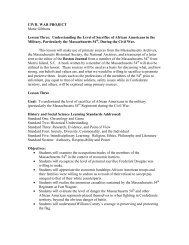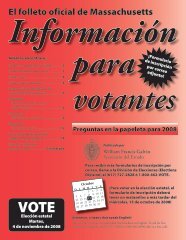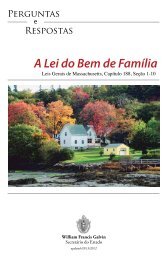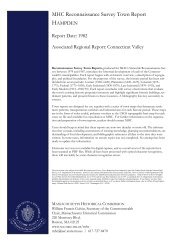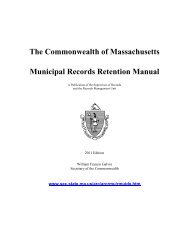Roads, Rails, and Trails - Secretary of the Commonwealth
Roads, Rails, and Trails - Secretary of the Commonwealth
Roads, Rails, and Trails - Secretary of the Commonwealth
Create successful ePaper yourself
Turn your PDF publications into a flip-book with our unique Google optimized e-Paper software.
Triangular “Levanna” points were <strong>the</strong> most common<br />
classifiable stone tool type at both sites.<br />
Of course, <strong>the</strong> dwellings were not lived in continuously<br />
for thous<strong>and</strong>s <strong>of</strong> years. They were periodically ab<strong>and</strong>oned or<br />
taken down for months or even years at a time. As evidence for<br />
periodic ab<strong>and</strong>onment <strong>the</strong> archaeologists found rodent burrows<br />
<strong>and</strong> <strong>the</strong> bones <strong>of</strong> scavengers within <strong>the</strong> living floors. The<br />
scenario <strong>the</strong>y came up with was that <strong>the</strong> house would<br />
periodically be ab<strong>and</strong>oned, with food waste left on <strong>the</strong> floor to<br />
be dealt with by scavenging animals. When people returned<br />
<strong>the</strong>y would set up a new dwelling right on <strong>the</strong> spot <strong>of</strong> <strong>the</strong> old<br />
one. They would set up new posts, coverings for <strong>the</strong> dwelling,<br />
<strong>and</strong> furnishings like sleeping platforms. They would cover <strong>the</strong><br />
floor with fresh mats. This had <strong>the</strong> effect <strong>of</strong> making a great<br />
many postmolds, some distinct, some faint, especially small<br />
ones (<strong>the</strong> larger support posts were more likely to be reused or<br />
set in <strong>the</strong> same place), <strong>and</strong> creating a deep deposit <strong>of</strong> floor<br />
sediments containing many artifacts. Over <strong>the</strong> many years <strong>of</strong><br />
foot traffic fragile artifacts like pottery, bone, <strong>and</strong> shell would<br />
be broken into tiny pieces, which is exactly what <strong>the</strong><br />
archaeologists found.<br />
31<br />
Pottery found inside <strong>the</strong> dwellings was almost<br />
invariably crushed into very small pieces. Of <strong>the</strong> more than<br />
1,000 pieces <strong>of</strong> pottery found at 19-NT-68, very few retained<br />
both exterior <strong>and</strong> interior surfaces. Most weighed less than<br />
three grams <strong>and</strong> because <strong>the</strong>y were so tiny <strong>the</strong>y provided<br />
minimal information about ceramic technology. But at 19-NT-<br />
50, <strong>the</strong> archaeologists got lucky. Here, <strong>the</strong>y found a cluster <strong>of</strong><br />
large sherds from a few broken pots that had been disposed <strong>of</strong><br />
in a shallow pit outside <strong>the</strong> dwelling, away from <strong>the</strong><br />
pulverizing foot traffic. They were able to fit some <strong>of</strong> <strong>the</strong><br />
sherds toge<strong>the</strong>r, enough to make <strong>the</strong> most complete example <strong>of</strong><br />
an ancient Native American pot yet found on Nantucket. This<br />
vessel was interesting in that it showed a wide variety <strong>of</strong><br />
designs <strong>and</strong> decorative techniques including lines incised with<br />
a sharp tool to make vertical <strong>and</strong> horizontal cross hatching<br />
around <strong>the</strong> rim. Below this was a zone <strong>of</strong> parallel horizontal<br />
incised lines. Below this zone <strong>the</strong> pot was decorated with<br />
“rocker stamping” decoration made by rocking a curved,<br />
too<strong>the</strong>d comb-like tool back <strong>and</strong> forth on <strong>the</strong> wet clay.<br />
This shallow pit where broken pots<br />
were discarded outside <strong>the</strong> dwelling<br />
yielded unusually large potsherds like<br />
this one.



